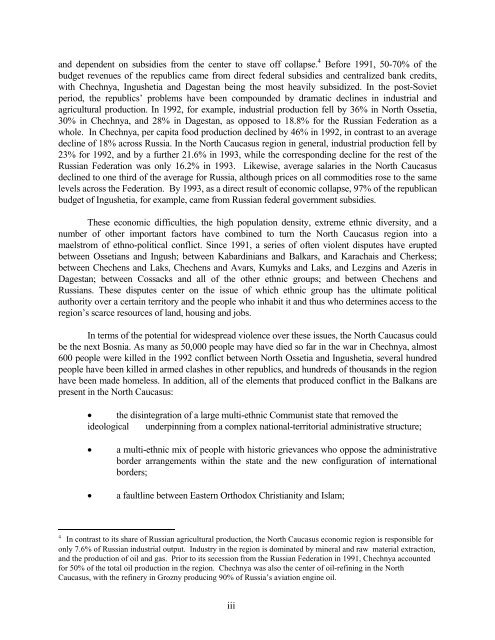RUSSIA'S TINDERBOX - Belfer Center for Science and International ...
RUSSIA'S TINDERBOX - Belfer Center for Science and International ...
RUSSIA'S TINDERBOX - Belfer Center for Science and International ...
You also want an ePaper? Increase the reach of your titles
YUMPU automatically turns print PDFs into web optimized ePapers that Google loves.
<strong>and</strong> dependent on subsidies from the center to stave off collapse. 4 Be<strong>for</strong>e 1991, 50-70% of the<br />
budget revenues of the republics came from direct federal subsidies <strong>and</strong> centralized bank credits,<br />
with Chechnya, Ingushetia <strong>and</strong> Dagestan being the most heavily subsidized. In the post-Soviet<br />
period, the republics’ problems have been compounded by dramatic declines in industrial <strong>and</strong><br />
agricultural production. In 1992, <strong>for</strong> example, industrial production fell by 36% in North Ossetia,<br />
30% in Chechnya, <strong>and</strong> 28% in Dagestan, as opposed to 18.8% <strong>for</strong> the Russian Federation as a<br />
whole. In Chechnya, per capita food production declined by 46% in 1992, in contrast to an average<br />
decline of 18% across Russia. In the North Caucasus region in general, industrial production fell by<br />
23% <strong>for</strong> 1992, <strong>and</strong> by a further 21.6% in 1993, while the corresponding decline <strong>for</strong> the rest of the<br />
Russian Federation was only 16.2% in 1993. Likewise, average salaries in the North Caucasus<br />
declined to one third of the average <strong>for</strong> Russia, although prices on all commodities rose to the same<br />
levels across the Federation. By 1993, as a direct result of economic collapse, 97% of the republican<br />
budget of Ingushetia, <strong>for</strong> example, came from Russian federal government subsidies.<br />
These economic difficulties, the high population density, extreme ethnic diversity, <strong>and</strong> a<br />
number of other important factors have combined to turn the North Caucasus region into a<br />
maelstrom of ethno-political conflict. Since 1991, a series of often violent disputes have erupted<br />
between Ossetians <strong>and</strong> Ingush; between Kabardinians <strong>and</strong> Balkars, <strong>and</strong> Karachais <strong>and</strong> Cherkess;<br />
between Chechens <strong>and</strong> Laks, Chechens <strong>and</strong> Avars, Kumyks <strong>and</strong> Laks, <strong>and</strong> Lezgins <strong>and</strong> Azeris in<br />
Dagestan; between Cossacks <strong>and</strong> all of the other ethnic groups; <strong>and</strong> between Chechens <strong>and</strong><br />
Russians. These disputes center on the issue of which ethnic group has the ultimate political<br />
authority over a certain territory <strong>and</strong> the people who inhabit it <strong>and</strong> thus who determines access to the<br />
region’s scarce resources of l<strong>and</strong>, housing <strong>and</strong> jobs.<br />
In terms of the potential <strong>for</strong> widespread violence over these issues, the North Caucasus could<br />
be the next Bosnia. As many as 50,000 people may have died so far in the war in Chechnya, almost<br />
600 people were killed in the 1992 conflict between North Ossetia <strong>and</strong> Ingushetia, several hundred<br />
people have been killed in armed clashes in other republics, <strong>and</strong> hundreds of thous<strong>and</strong>s in the region<br />
have been made homeless. In addition, all of the elements that produced conflict in the Balkans are<br />
present in the North Caucasus:<br />
• the disintegration of a large multi-ethnic Communist state that removed the<br />
ideological underpinning from a complex national-territorial administrative structure;<br />
• a multi-ethnic mix of people with historic grievances who oppose the administrative<br />
border arrangements within the state <strong>and</strong> the new configuration of international<br />
borders;<br />
• a faultline between Eastern Orthodox Christianity <strong>and</strong> Islam;<br />
4 In contrast to its share of Russian agricultural production, the North Caucasus economic region is responsible <strong>for</strong><br />
only 7.6% of Russian industrial output. Industry in the region is dominated by mineral <strong>and</strong> raw material extraction,<br />
<strong>and</strong> the production of oil <strong>and</strong> gas. Prior to its secession from the Russian Federation in 1991, Chechnya accounted<br />
<strong>for</strong> 50% of the total oil production in the region. Chechnya was also the center of oil-refining in the North<br />
Caucasus, with the refinery in Grozny producing 90% of Russia’s aviation engine oil.<br />
iii
















